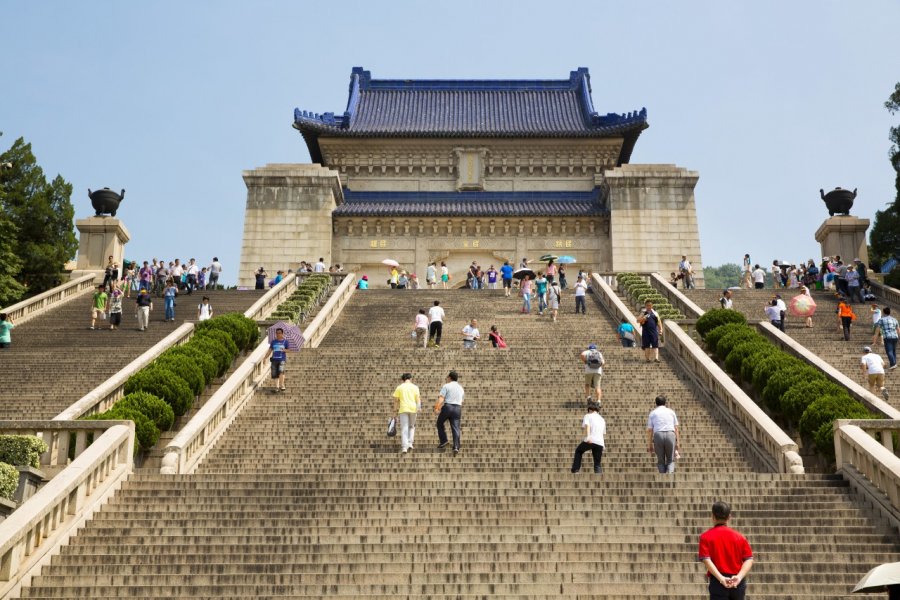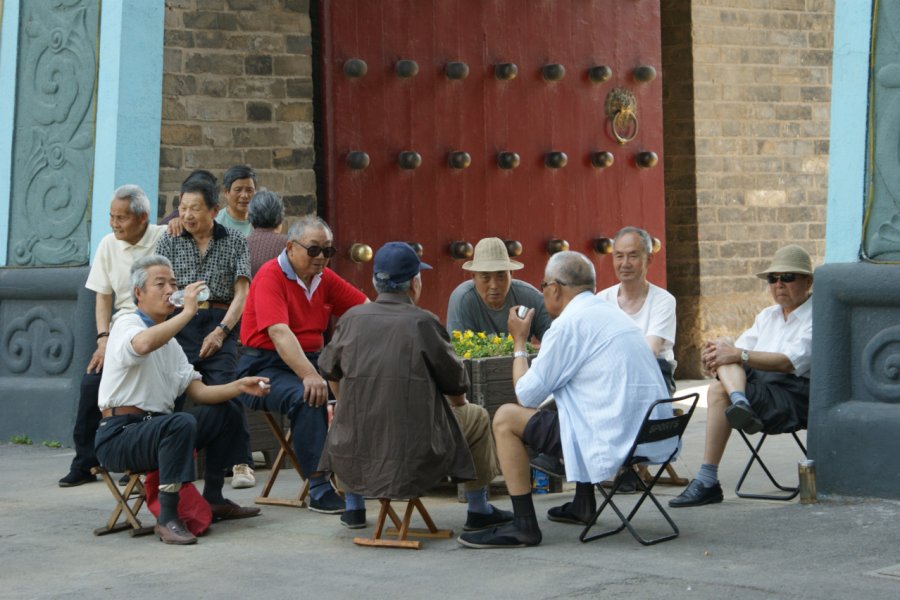Travel Guide Nanjing - Nanjing 南京
Find an accommodation
Advertising
With Xi 'an, Nankin is the largest city in China offering the largest number of first-class historic sites. Its ancient history, its status as imperial capital and then Republican, but also the terrible massacre that took place there in 1937, make it a separate place in China. The capital of Jiangsu Province enjoys excellent geographical location. It occupies the heart of the country's most fertile region, known as the «land of fish and rice».The town stretches to the mouth of the Yangtse Delta, a meeting point between the north and south of the country. Protected by hills, watered by one of the most important rivers in the world, the Yangtse, Nankin knew a turbulent past. Ten times capital during its history, it was named «City of the Ten Capitals» (Shichao Duhui). Founded at the end of the period of the Kingdoms (480-221 BC), Nankin was chosen as the capital by the Ming dynasty and then by the rebels of the secret Taiping society, finally by the young Republic of China in 1911. In his 5,000 years of existence, Nankin also represented a refuge for the rebels and the contenders to the imperial throne.History.Nankin enters history under the Han dynasty (206 BC at 220 Apr. ). This small blacksmith center becomes a regional administrative and economic center. During the fall of the dynasty, the city obtains the status of «first city of the kingdom of Wu» during the period of the Three Kingdoms (220-280).For the first time, it accesses the status of capital. Zhuge Liang, the famous Prime Minister of the Kingdom of Shu, on mission to Nankin, intoxicated by the beauty of the site, perched on stone hill: «The mountains purple (Zijin Shan) serdiced like the dragon, the Stone City ready to bounce like the lion, this is the dream place for an Emperor!» " "In 317, the Kingdom of Wu is dismissed by the Jin from the North. A hundred years later, the first Emperor of Song forcibly established himself in Nankin. A tormented period follows three dynasties in a century. The south dynasties, Nan Chao, elect the city as capital.Then known as Jian Kang, Nankin plunged into oblivion in 589. Wen Di, the first emperor of the Sui (581-618), preferred Xi 'an, a new capital of a reunited China. The city comes out of the shadow under the southern Tang (937-975), elected prefecture of Jiang Ning.In 1356, the city fell under the assaults of rebel leader Zhu Yuanzhang, head of a peasant revolt. This victory sealed the fate of the Mongolian dynasty that his troops had just crushed. In 1368, the first Emperor of Ming, self-proclaimed, settled in Nankin. The city then enters a true golden age, the emperor Hong Wu confusing the affront of urbanism and architecture worthy of a great reunited empire.Power, gigantism and greatness of an urban project longer than half a century: we build 56 km of ramparts, palaces, everything in a perfect symmetry alignment. Hong Wu even designs his mortuary remains, a true palace in the purple mountains. His son, Emperor Yong, nevertheless settled in Beijing in 1421.Nankin continues to grow. In the fifteenth century, its shipyards build 300-foot long junks, equipped to sail on the high seas. At that time, the city is famous for its foundry workshops, ceramic ovens, brocade fabrics, printing works, the best in the world. A great cultural center, the city attracts mathematicians, astronomers, painters and philosophers. The sixteenth century is a period of prosperity for the city: the silk trade is flourishing and rice grain stores are not distraught.The seventeenth and eighteenth centuries are right in the splendor of Nankin. Famines, floods and fires take place on the lower Yangtsé region, reducing the capital to nil. His fate takes a new turn with the opium wars and Western intrusion into China.In the 1840 s, the British navy seized Zhenjiang, a downstream port on the Yangtse. In 1842, the signature of the famous Nankin treaty was signed. According to Tongzhi, Emperor Qing is the only way to prevent the invasion of the city. The Qing believe that they can stop the dramatic advance of foreigners in Chinese territory. Nankin becomes an open port under Western pressure. Therefore, the city reflects the history of a torn China and Nankin knows the darkest events in its history. In 1853, after crushing southern China, Hong Xiuquan, leader of the pro-Christian movement of Taiping, led the revolt (1861-1864) to the gates of Nankin. He decided to install his capital, Tian Jin (Celestial Capital).From 1864 onwards, foreigners regarded this rebellion as a threat to their interests. They join forces with imperial troops, encircle and annihilate the Taiping. Several months of bombing put the city on fire and blood, exterminating several thousand rebels. In 1864, at the fall of Nankin, their leader, Hong Xiuquan suicide. The story tells us that 100,000 faithful committed suicide with her side to avoid falling into the hands of the Manchies soldiers.Today, there is still much of its wall that bears witness to its long history. Theater of the signing of the "Unequal Treaties" of 1842 that bear its name, the "Southern Capital" (Nan - Jing) is also infamous for what is now known as the "Nanjing Massacre". According to estimates, there were nearly 200,000 Chinese massacred by Japanese troops in 1937.After a period of anarchy, the young Republic of China was established in 1911 under Sun Yat-sen. She elects Nankin as capital… for little time, because the Lord of the War Yuan Shikai, the successor of Sun, moves power to Beijing. In 1927, Chang Kai-chek, leader of Guomingdang, the nationalist party, realized Sun Yat-sen's wish: Nanjing has the most beautiful buildings in Republican China. Sun Yat-sen's mausoleum is built, a key figure in China's history (death in 1925), the Ministry of Foreign Affairs (at Zhongshan Beilu), the National Assembly (the current People's Palace), and the University of Nankin (Nanjing Dnanjing Dnanking) Axue). A large-scale urban project involving the largest contemporary Chinese architects assisted by brilliant Western experts. In 1937, Japanese troops attacked China, took the city and massacred tens of thousands of its inhabitants. In 1949 Mao finally settled the capital in Beijing. In 1966, the launch of the Cultural Revolution began with the dismissal of the president of the University of Beijing. Nankin rushes to follow the example, doing the same with the dean of his university, who spends the rest of the Revolution cleaning the toilet…In 1976, faithful to its troubled political history, the city became the cradle of the first anti-radical movements that occurred after the death of Zhou Enlai. Nankin also raises his voice in 1989.The city today.Today, Nankin has a prominent place in modern China. A major regional industrial and port center, Nankin brings together many leading sectors (chemistry, mechanical construction, electronics, petroleum refining…). A university town, housed in its walls the prestigious University of Nankin, it has more than 5 million inhabitants. A neighbor of Shanghai, she takes many advantages from the prosperity of his opulent congener, which she accompanies in his economic takeoff. In addition, the regional capital is home to the regional military headquarters, responsible for the defense system against Taiwan.The places deserve a visit for the richness of their history. Nankin, with its narrow streets, is a pleasant step and allows beautiful walks on the purple mountain and its surroundings.
What to visit Nanjing - Nanjing 南京?
Advertising
Suggested addresses Nanjing - Nanjing 南京
Weather at the moment
Advertising
Organize your trip with our partners Nanjing - Nanjing 南京
Transportation
Book your plane tickets
Car Rental
Boat rental
Accommodation & stays
Find a hotel
Holiday rental
Find your campsite
Tailor-made trip
Immersion travel
Services / On site
Activities & visits
Find a doctor
Find unique Stay Offers with our Partners
Pictures and images Nanjing - Nanjing 南京
Other destinations nearby Nanjing - Nanjing 南京
100 km away















